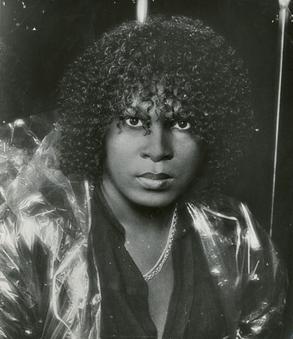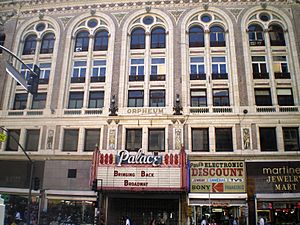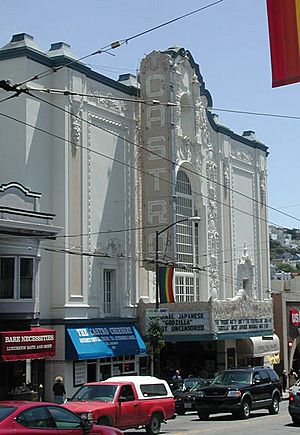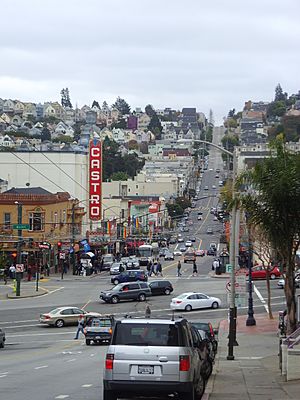Sylvester (singer) facts for kids
Quick facts for kids
Sylvester
|
|
|---|---|

Sylvester in 1979
|
|
| Born |
Sylvester James Jr.
September 6, 1947 Los Angeles, California
|
| Died | December 16, 1988 (aged 41) San Francisco, California, U.S.
|
| Cause of death | AIDS-related complications |
| Resting place | Inglewood Park Cemetery, Inglewood, California, U.S. |
| Occupation |
|
| Musical career | |
| Genres | |
| Instruments |
|
| Years active | 1962–1988 |
| Labels |
|
Sylvester James Jr., known as Sylvester, was an American singer and songwriter. He became famous for his amazing high-pitched singing voice, called a falsetto. He was a star in the disco, rhythm and blues (R&B), and soul music worlds. People loved his exciting and unique style. He had big hit songs in the late 1970s and 1980s.
Born in Los Angeles, California, Sylvester loved singing from a young age. He especially enjoyed singing in his church's gospel choir. When he was 22, he moved to San Francisco. There, he joined a performance group called the Cockettes. He showed off his talent and created his own special parts in their shows. He was inspired by famous singers like Billie Holiday and Josephine Baker. Later, he started his own band, Sylvester and his Hot Band.
Sylvester then began a solo career. He teamed up with talented backing singers Martha Wash and Izora Rhodes. They were known as Two Tons O' Fun. His album Step II (1978) was a huge success. It featured famous songs like "You Make Me Feel (Mighty Real)" and "Dance (Disco Heat)". These songs became hits in America and Europe. Later, he worked with his friend Patrick Cowley and released more music. This included the popular track "Do Ya Wanna Funk". Sylvester also worked hard to raise awareness about HIV/AIDS, a serious illness. He passed away in 1988 from health problems related to AIDS. He left the money from his future music sales to charities helping people with HIV/AIDS.
Sylvester was often called the "Queen of Disco." He was very well-known in San Francisco. He even received the key to the city. In 2005, he was honored by being added to the Dance Music Hall of Fame. His life story has been told in books, documentaries, and even a musical.
Contents
Early Life and Musical Beginnings
Growing Up in Los Angeles
Sylvester James was born on September 6, 1947. He grew up in the Watts area of Los Angeles, California. His family was middle-class. His mother, Letha Weaver, came from a family that owned farmland. Sylvester grew up with his brothers. People in their community knew them by nicknames. Sylvester's nickname was "Dooni."
Letha was very religious and attended a Pentecostal church. Sylvester and his brothers went with her. He discovered his love for gospel music there. He started singing when he was only three years old. He often performed in church. People at church noticed he was different from other boys. They described him as "pretty" and not as "rough." He preferred spending time with girls and women, like his grandmother. He enjoyed reading, listening to music, and playing the piano.
When Sylvester was young, he faced some difficult experiences at his church. Because of this, he stopped attending when he was 13. His relationship with his mother and stepfather became strained. He eventually left home.
The Disquotays: A Creative Group
After leaving home, Sylvester stayed with friends and relatives. His grandmother Julia was especially supportive of him. He made friends in the local Black community. They formed a group called the Disquotays. His best friend in the group was Duchess. The Disquotays loved to dress up in women's clothing and wigs. They held fun parties.
Sylvester often dressed in female clothing, which was unusual at the time. He worked various jobs. He cooked at McDonald's and worked as a make-up artist. He graduated from Jordan High School in 1969. By the end of the 1960s, the Disquotays started to go their separate ways. Sylvester began to develop a unique look, mixing male and female styles.
The Cockettes: Experimental Performances
Sylvester met Reggie Dunnigan. Reggie invited him to San Francisco. He wanted Sylvester to join the "Chocolate Cockettes." This was a group of Black members in an experimental performance art group. The group was called the Cockettes. It was founded in 1970. The Cockettes were known for their wild shows that made fun of popular culture. They were part of a movement for equal rights for people. They lived a shared lifestyle.
Sylvester was tired of Los Angeles. He liked San Francisco's reputation as a welcoming place for different kinds of people. The Cockettes were impressed by his falsetto singing voice and piano skills. He joined their show Radio Rodeo. Sylvester often had his own scenes in the Cockettes' shows. He would sing blues and jazz songs. He was inspired by singers like Billie Holiday and Josephine Baker. He sometimes used the stage name "Ruby Blue."

In 1971, Sylvester had his own show, Sylvester Sings. It was at the Palace Theater. The Cockettes gained more attention. Rolling Stone magazine praised Sylvester's performances. The group went to New York City. Their shows there were not well-received by critics. However, Sylvester's act was praised. He realized he could have a better career as a solo artist. He decided to leave the Cockettes.
Launching a Solo Music Career
Sylvester and his Hot Band
Back in San Francisco, Sylvester formed a band called the Hot Band. They played rock music. The band got a deal with Blue Thumb Records. They released two albums: Sylvester and his Hot Band and Bazaar. These albums included cover songs and some original music. Unfortunately, the albums didn't sell well.
The band toured the United States. But they faced some challenges. Working with Sylvester was sometimes difficult. Due to the lack of success, the Hot Band left Sylvester in late 1974. His record contract was also canceled.
Finding Two Tons O' Fun
Without a band or record deal, Sylvester formed a new group. He eventually found two amazing backing singers: Martha Wash and Izora Rhodes. They called themselves Two Tons O' Fun. Later, they became known as the Weather Girls. They became close friends with Sylvester. They worked with him for many years.
Sylvester and his new band started playing in clubs. In 1976, they got a regular job at The Palms nightclub. This led to Harvey Fuqua, a producer from Motown, noticing Sylvester. Fuqua signed Sylvester to a solo deal with Fantasy Records in 1977.
In 1977, Sylvester released his third album, simply titled Sylvester. The album had a dance music feel. It included his own songs and covers, like "Over and Over" by Ashford & Simpson. This song became a small hit in the U.S. It also did well in Mexico and Europe.
Becoming a Disco Superstar
Step II: Big Hits and Fame
Sylvester's fame grew. He often performed at The Elephant Walk, a club in the Castro district of San Francisco. He became friends with Harvey Milk. Milk was an important local politician. He was one of the first openly gay people elected to public office in California. Sylvester even performed at Milk's birthday party. In 1978, Sylvester appeared in the movie The Rose starring Bette Midler.
In September 1978, Sylvester released his album Step II. This album was heavily influenced by disco music. Disco was very popular at the time. For this album, Sylvester worked with musician Patrick Cowley. Cowley used synthesizers to create new sounds. Step II had two huge hit singles: "You Make Me Feel (Mighty Real)" and "Dance (Disco Heat)".
Both songs topped the American dance charts. They were popular in the U.S. and other countries. The album Step II was also a big success. It was certified gold. Rolling Stone magazine called it "as good as disco gets." "You Make Me Feel (Mighty Real)" became a classic disco anthem. Sylvester's music combined gospel and R&B styles with electronic beats. This created a unique and powerful sound.
Sylvester promoted his music in London, England. He was very popular there. He also appeared on TV shows like American Bandstand. He toured across the U.S. His success helped connect disco music with the gay community in people's minds.
Later Music and Life's Challenges
More Albums and New Directions
After the success of Step II, Sylvester released the album Stars in 1979. The title track was written by Patrick Cowley. On March 11, 1979, Sylvester performed at the San Francisco War Memorial Opera House. During the show, Mayor Dianne Feinstein awarded him the key to the city. She declared it "Sylvester Day." This concert was recorded and released as the live album Living Proof.
Sylvester continued to support the gay community. He performed at events like the San Francisco Gay Freedom Day parade. He also met singer Jeanie Tracy. She joined his backing singers. The Two Tons O' Fun started their own successful career as The Weather Girls.
In 1980, Sylvester released Sell My Soul. This album moved away from disco. It focused more on soul-inspired dance tracks. His final album for Fantasy Records was Too Hot to Sleep (1981). It featured soul, ballads, and gospel-style songs. These albums did not sell as well as Step II.
Moving to Megatone Records
Sylvester felt that Fantasy Records had not paid him all the money he was owed. He left the label. In 1982, he successfully sued them. However, he never received most of the money.
He then signed with Megatone Records. This was a smaller company founded by his friends Patrick Cowley and Marty Blecman. This label focused on dance music for clubs. His first album with Megatone was All I Need (1982). One of the most famous songs from this period was "Do Ya Wanna Funk". This was a Hi-NRG dance track co-written with Cowley. It was a big hit in dance clubs worldwide.
Sadly, Patrick Cowley was suffering from HIV/AIDS. This was a new and serious illness at the time. He passed away in November 1982. Sylvester was deeply affected by his friend's death.

In 1983, Sylvester released Call Me. But it wasn't a big commercial success. He became very involved in helping people with HIV/AIDS. He volunteered at a hospital lounge for patients. He performed at benefit concerts to raise money and awareness. In 1984, he performed a special show called "One Night Only" at the Castro Theatre. He looked back at his career during this show.
His next album was M-1015 (1984). It had a fast, energetic Hi-NRG sound. His final album, Mutual Attraction (1986), was released by Warner Bros. One single from this album, "Someone Like You", became a number one dance hit.
Final Years and Helping Others
In 1985, Sylvester's close friend, Rick Cranmer, learned he had HIV. Rick passed away in 1987. Sylvester was heartbroken. He also realized he was likely infected with the virus. He developed a cough, which was one of the first signs.
Even though he was getting sick, Sylvester continued to work on music and perform when he could. He was diagnosed with AIDS. He was cared for by his mother and his friend Jeanie Tracy. In 1988, though he was very ill and in a wheelchair, he attended San Francisco's Gay Freedom Parade. The crowds cheered his name as he passed. The Castro Street Fair that year was named "A Tribute to Sylvester."
Sylvester was open about having AIDS. He wanted to raise awareness, especially in the African-American community. He gave interviews and spoke about his illness. He passed away in his bed on December 16, 1988, at the age of 41. He had planned his own funeral. He wanted to be dressed in a red kimono. The service was held at his church, the Love Center. Many people attended. He was buried in Inglewood Park Cemetery.
Sylvester's Unique Style and Personality
Sylvester had a vibrant and colorful personality. He often wore clothes that mixed male and female styles. He expressed himself freely. He said his public image was "an extension of me, the real me." Friends described him as quiet, thoughtful, and generous. He could also be determined and always spoke his mind.
Sylvester was known for being a perfectionist. This was especially true about his music and appearance. He spent his money generously on himself, his friends, and his family. He was openly gay throughout his career. He became an important figure for the gay community. He believed his music was for everyone, no matter their background.
Sylvester grew up in the Pentecostal church. Religion remained important to him throughout his life. He often compared the joyful feelings of performing on stage to the feelings in a gospel choir. Later in life, he joined the Love Center Church in East Oakland.
Legacy: Remembering Sylvester
Impact on Music and Dance
Sylvester earned the nickname "Queen of Disco" in the late 1970s. His music, especially songs like "You Make Me Feel (Mighty Real)" and "Dance (Disco Heat)," became anthems for a generation. His powerful falsetto voice and unique style had a big influence on disco. It also influenced later electronic dance music. He used his music to express joy and freedom.
Music experts have said that Sylvester's use of his high singing voice to express his feelings was groundbreaking. He represented the gay roots of disco music. He showed how electronic music could be a way to express individuality.
Tributes and Honors for Sylvester
In his will, Sylvester left the royalties (money earned from sales) from his music to two HIV/AIDS charities. These were Project Open Hand and the AIDS Emergency Fund. These charities continue to receive money from his music sales.
On September 19, 2005, Sylvester was added to the Dance Music Hall of Fame. He joined other music legends like Chic and Gloria Gaynor. In 2016, Billboard magazine ranked him as the 59th most successful dance artist of all time. In 2023, Rolling Stone magazine listed Sylvester as one of the 200 Greatest Singers of All Time. In 2019, his song "You Make Me Feel (Mighty Real)" was chosen by the Library of Congress. It was preserved in the National Recording Registry because it is "culturally, historically, or aesthetically significant."
Sylvester's life has been the subject of biographies, documentaries, and even an Off-Broadway musical. The musical is called Mighty Real: A Fabulous Sylvester Musical. In 2014, he was honored on the Rainbow Honor Walk in San Francisco's Castro district. This walk recognizes LGBTQ+ people who have made important contributions.
Discography
Studio Albums
| Year | Album | Peak chart positions | Certifications | Record label | ||||||||||
|---|---|---|---|---|---|---|---|---|---|---|---|---|---|---|
| US |
US R&B |
AUS |
CAN |
|||||||||||
| 1973 | Sylvester & the Hot Band* | — | — | — | — | Blue Thumb | ||||||||
| Bazaar* | — | — | — | — | ||||||||||
| 1977 | Sylvester | — | — | — | — | Fantasy | ||||||||
| 1978 | Step II | 28 | 7 | 74 | 59 |
|
||||||||
| 1979 | Stars | 63 | 27 | — | 59 | |||||||||
| 1980 | Sell My Soul | 147 | 44 | — | — | Fantasy/Honey | ||||||||
| 1981 | Too Hot to Sleep | 156 | 51 | — | — | |||||||||
| 1982 | All I Need | 168 | 35 | 98 | — | Megatone | ||||||||
| 1983 | Call Me | — | — | — | — | |||||||||
| 1984 | M-1015 | — | — | — | — | |||||||||
| 1986 | Mutual Attraction | 164 | 46 | — | — | Warner Bros./Megatone | ||||||||
| "—" denotes a recording that did not chart or was not released in that territory. | ||||||||||||||
- Credited as Sylvester & the Hot Band.
Live Albums
| Year | Album | Peak chart positions | Record label | |
|---|---|---|---|---|
| US |
US R&B |
|||
| 1979 | Living Proof | 123 | 45 | Fantasy |
Compilation Albums
| Year | Album | Peak | Record label |
|---|---|---|---|
| UK |
|||
| 1979 | Mighty Real | 62 | Fantasy |
| 1983 | Sylvester's Greatest Hits: Nonstop Dance Party | — | |
| 1988 | The 12 X 12 Collection | — | Megatone |
| 1989 | The Original Hits | — | Fantasy |
| Immortal | — | Megatone |
See also
 In Spanish: Sylvester (cantante) para niños
In Spanish: Sylvester (cantante) para niños


